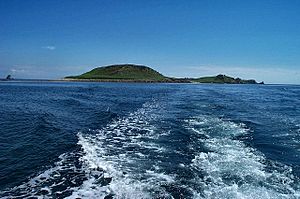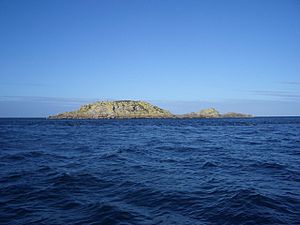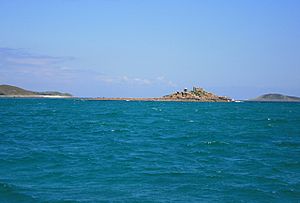Eastern Isles facts for kids
| Site of Special Scientific Interest | |

View of a portion of the Eastern Isles
|
|
| Area of Search | Cornwall |
|---|---|
| Coordinates | 49°57′06″N 6°15′24″W / 49.9517°N 6.2567°W |
| Interest | Biological |
| Area | 83.8 hectares (0.838 km2; 0.324 sq mi) |
| Notification | 1971 |
The Eastern Isles (Cornish: Enesow Goonhyli, meaning islands of the salt water downs) are a group of twelve small islands. You won't find anyone living on them today! They are part of the beautiful Isles of Scilly in England, an area known for its amazing natural beauty.
These islands are super important for nature. They are a Site of Special Scientific Interest (SSSI) because of their special plants and animals. People have lived on or visited these islands for a very long time. There's evidence from the Bronze Age (thousands of years ago) with ancient burial mounds called cairns and entrance graves. Later, during the Iron Age, people built field systems. There was even a Roman shrine found on one island called Nornour!
Contents
- Exploring the Eastern Isles: Geography and Landscape
- Island Foundations: Geology and Formation
- Amazing Wildlife: Plants and Animals
- Island Spotlights: Discovering Each Isle
- Great Ganilly: The Largest Island
- The Arthur Islands: Great, Middle, and Little Arthur
- Menawethan: The Tree Stone Island
- Little Ganilly: The Small Salt Water Down
- Great and Little Innisvouls: Wether Islands
- Great and Little Ganinick: Wild Garlic Place
- Nornour: Facing the Mainland
- Ragged Island: Unexpected Plants
- Guther's: Channels Island
- Hanjague: The Windy One
- English Island: A Rocky Spot
Exploring the Eastern Isles: Geography and Landscape
The Eastern Isles are located to the south-east of St Martin's island. They are part of a protected area called the Isles of Scilly Area of Outstanding Natural Beauty. This means the landscape and wildlife are very special and need to be looked after.
These islands are not as open to strong winds as some other islands nearby. This means their soil doesn't get as much salty sea spray. Because of this, special habitats like coastal grassland and maritime heath have survived here. If animals like sheep still grazed here in summer, there would be even more grassland. Instead, some areas are now covered in thick bramble bushes.
Here are the islands listed by their size:
- Great Ganilly (13.83 hectares)
- Great, Middle and Little Arthur (7.75 hectares)
- Menawethan (2.81 hectares)
- Little Ganilly (2.71 hectares)
- Great Innisvouls (1.82 hectares)
- Great Ganinick (1.82 hectares)
- Nornour (1.64 hectares)
- Little Ganinick (1.15 hectares)
- Little Innisvouls (0.98 hectares)
- Ragged Island (0.97 hectares)
- Guther's (0.47 hectares)
- Hanjague (0.30 hectares)
Island Foundations: Geology and Formation
The islands are made of a type of rock called granite, which is covered by sand blown by the wind. Some of the islands are connected by rocky ridges and sandy paths. At low tide, you can sometimes see them as one bigger island.
Long ago, when the Romans were in England, this area was a flat plain. What we now call the Eastern Isles were just small hills on that plain. The Isles of Scilly are famous for their "tied islands." These are islands that get connected by a sandy bar, like a natural bridge. This sandy bar is called a tombolo.
Four islands here show different stages of this process. Teän (not one of the Eastern Isles) is an example of a tied island. Great Arthur, Great Ganinick, and Little Ganinick also show how islands can become linked by sand.
Amazing Wildlife: Plants and Animals
Most of the Eastern Isles are covered in thick bramble bushes and bracken ferns. Along the coasts, you'll find grassland. A plant called Goldenrod is very common in the heath areas on the higher parts of the islands.
The heath areas have plants like heather and bell heather. Experts are looking into whether grazing animals would help these plants grow better. It's hard to study plants on these remote islands, so there aren't as many records as in some other places. However, surveys in the past have found over 100 different types of higher plants.
Some islands even have unique plants found nowhere else in the Eastern Isles. For example, an oak tree was found on Great Gannick. Other rare plants like butcher's-broom and wood spurge have also been seen there. The very rare orange bird's-foot plant grows on the northern side of Great Ganilly.
Marine Mammals: Grey Seals
The Eastern Isles are one of the main places where grey seals have their babies. The seals use these islands for resting too. Other mammals found here include rabbits, brown rats (which can be a problem for the wildlife), house mouses, and the special Scilly shrew.
Bird Life: Seabird Colonies
These islands are also home to many breeding seabirds. You can find three types of gulls here. Other birds include the common shag, great cormorant, northern fulmar, razorbill, and puffin. To protect these birds during their breeding season, some islands are closed to visitors from April 15th to August 20th.
Island Spotlights: Discovering Each Isle
Great Ganilly: The Largest Island
Great Ganilly (Cornish: Goonhyli Meur, meaning great salt water down) is the biggest of the Eastern Isles. It has two hills connected by a low sandy strip. The northern hill is the highest point. On its top, you can see the remains of an ancient Bronze Age entrance grave. Stones from this old grave were used to build a pyramid-shaped marker for boats.
Other signs of people living here long ago include a hut circle (the remains of a round house) and old field systems. A freshwater spring on the island would have made it possible for people to live here, especially during the time when people burned seaweed to make kelp. The hills have maritime heath, and the lower parts are covered in thick bracken.
Many different plant species have been found here, including sea-kale and common thyme. The rare orange bird's-foot plant also grows on the heath. Animals like rabbits, brown rats, house mice, and Scilly shrews live on Great Ganilly.
The Arthur Islands: Great, Middle, and Little Arthur
The Arthurs (Cornish: Ar Dhor, meaning facing land) are three rocky islands. They are connected by two beaches that form a curve around a bay called Arthur Porth. Great Arthur is the largest. It has coastal grassland and sand dunes.
There are three ancient entrance graves on the top of Great Arthur, connected by an old stone wall. These are surrounded by maritime heath. The sandy areas have marram grass, which helps keep the dunes stable. This also protects other plants that don't usually grow near the sea.
Middle Arthur has a unique boat-shaped entrance grave on its summit. In 1953, a burial urn with bones and flint pieces was found here. Little Arthur has bracken on its deeper soils and heath on its top. It also has a small area of sand dunes with a plant called slender St John's-wort, which is rare in the Isles of Scilly.
Menawethan: The Tree Stone Island
Menawethan (Cornish: Men an Wedhen, meaning the tree stone) is a steep island to the south-east. Its plants are typical of islands where many seabirds breed. This was one of the first islands where experts worked to remove rats to protect the wildlife.
Some parts of the island are covered in hottentot fig, which gulls might have carried there. Other plants like thrift, sea campion, and tree-mallow also grow here. A rare plant called brookweed grows among the rocks near the shore. grey seals use the rocky shore to rest. There's also an ancient Bronze Age cairn (burial mound) on the top of the island.
Little Ganilly: The Small Salt Water Down
Little Ganilly (Cornish: Goonhyli Bian, meaning little salt water down) is just north of Little Arthur. It has a small heath area on its top. Bracken covers the slopes, and there are coastal grassland and cliff plants along the shore. Several small caves can be found on the east side. Brown rats and grey seals (who use the island for resting) are the only mammals recorded here.
Great and Little Innisvouls: Wether Islands
Great Innisvouls (Cornish: Enys Vols Meur, meaning great wether island) has a small area of coastal grassland and bracken. Little Innisvouls (Cornish: Enys Vols Bian, meaning little wether island) has plants that grow along the shoreline. Both islands have breeding seabirds, and the special Scilly shrew has been seen on Great Innisvouls.
North-east of Little Innisvouls is a small rock called Mouls. A rare type of pseudoscorpion was found there in 1927.
Great and Little Ganinick: Wild Garlic Place
The islands of Great Ganinick and Little Ganinick (Cornish: Kenninek, meaning place of wild garlic) are good examples of how two islands can start to link up with a sand bar (a tombolo). The sand is building up from Little Ganinick towards the larger island.
Great Ganinick has the only known oak tree in the Eastern Isles! It was first described in 1938 as being about 76 cm tall. This island is rich in plant species, including butcher's-broom and wood spurge. Little Ganinick has grassland, shoreline plants, and seabird colonies.
Nornour: Facing the Mainland
Nornour (Cornish: Ar Nor, meaning facing the mainland) is a hill covered in bracken, north of Great Ganilly. At low tide, you can walk to it across a rocky path. People lived on Nornour for a long time during the Bronze and Iron Ages. Back then, Nornour was part of a much larger island.
After a storm in 1962, sand dunes eroded and uncovered ancient hut circles (the remains of round stone buildings). Eleven of these buildings were found and studied. Inside, archaeologists found doorways, walls, steps, fireplaces, and stone-lined pits. Sadly, two of the buildings have since been covered by beach boulders again.
Many Roman objects were found in two of the western huts. These included over three hundred brooches (decorative pins) from the 1st to 3rd centuries AD. Coins, glass, tiny pots, and clay figures were also found. The oldest coins were from the Roman Emperor Vespasian (AD 69–79). The latest finds show the site was still used in the late 4th century.
The brooches came from many places across Britain and Europe. This suggests that the objects were not for trade. Instead, they might have been offerings to a local god or goddess, perhaps Sulis. This means the site was likely a Roman shrine. It's unlikely these objects came from a shipwreck because they cover such a long period of time. Even with efforts to protect it, the sea continues to erode this important archaeological site.
You can also see the boilers of an old paddle steamer called the Earl of Arran at low tide on the western shore. It hit a rock in 1872 while trying to take a shortcut.
Nornour has a small heath area with heather. Rare plants like Portland spurge, balm-leaved figwort, butcher's-broom, sea spurge, and sea spleenwort have been recorded here. However, a colony of the endangered shore dock hasn't been seen since 1970.
Ragged Island: Unexpected Plants
Ragged Island has two surprising plants: Chilean hard-fern and borage. No one knows exactly how they got there! Fern spores can travel long distances by wind. Other plants found here include thrift, scurvy grass, and sea beet.
Guther's: Channels Island
Guther's (or Gunther's) (Cornish: Goothow, meaning channels) is a small island on the western side of the Eastern Isles. It has limited plants like grass, docks, and sea beet. Greater black-backed and herring gulls nest here, as do common shags. You can sometimes walk to this island from St Martin's at very low tides, but you must be careful not to get stuck!
Hanjague: The Windy One
Hanjague (Cornish: An Wynjek, meaning the windy one) is a tall rock sticking out of the sea. It's about one kilometer north-east of Great Gannilly and is the most eastern island in the area. This island has no plants and is used by birds as a resting spot.
English Island: A Rocky Spot
This rock is located between English Island point on St Martin's (to the north) and Nornour (to the south-east).





